The AMD Ryzen 3 3300X and 3100 CPU Review: A Budget Gaming Bonanza
by Dr. Ian Cutress on May 7, 2020 9:00 AM ESTCPU Performance: System Tests
Our System Test section focuses significantly on real-world testing, user experience, with a slight nod to throughput. In this section we cover application loading time, image processing, simple scientific physics, emulation, neural simulation, optimized compute, and 3D model development, with a combination of readily available and custom software. For some of these tests, the bigger suites such as PCMark do cover them (we publish those values in our office section), although multiple perspectives is always beneficial. In all our tests we will explain in-depth what is being tested, and how we are testing.
All of our benchmark results can also be found in our benchmark engine, Bench.
Application Load: GIMP 2.10.4
One of the most important aspects about user experience and workflow is how fast does a system respond. A good test of this is to see how long it takes for an application to load. Most applications these days, when on an SSD, load fairly instantly, however some office tools require asset pre-loading before being available. Most operating systems employ caching as well, so when certain software is loaded repeatedly (web browser, office tools), then can be initialized much quicker.
In our last suite, we tested how long it took to load a large PDF in Adobe Acrobat. Unfortunately this test was a nightmare to program for, and didn’t transfer over to Win10 RS3 easily. In the meantime we discovered an application that can automate this test, and we put it up against GIMP, a popular free open-source online photo editing tool, and the major alternative to Adobe Photoshop. We set it to load a large 50MB design template, and perform the load 10 times with 10 seconds in-between each. Due to caching, the first 3-5 results are often slower than the rest, and time to cache can be inconsistent, we take the average of the last five results to show CPU processing on cached loading.
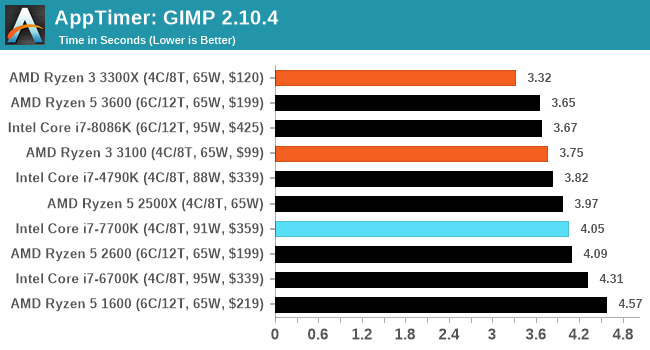
3D Particle Movement v2.1: Brownian Motion
Our 3DPM test is a custom built benchmark designed to simulate six different particle movement algorithms of points in a 3D space. The algorithms were developed as part of my PhD., and while ultimately perform best on a GPU, provide a good idea on how instruction streams are interpreted by different microarchitectures.
A key part of the algorithms is the random number generation – we use relatively fast generation which ends up implementing dependency chains in the code. The upgrade over the naïve first version of this code solved for false sharing in the caches, a major bottleneck. We are also looking at AVX2 and AVX512 versions of this benchmark for future reviews.
For this test, we run a stock particle set over the six algorithms for 20 seconds apiece, with 10 second pauses, and report the total rate of particle movement, in millions of operations (movements) per second. We have a non-AVX version and an AVX version, with the latter implementing AVX512 and AVX2 where possible.
3DPM v2.1 can be downloaded from our server: 3DPMv2.1.rar (13.0 MB)
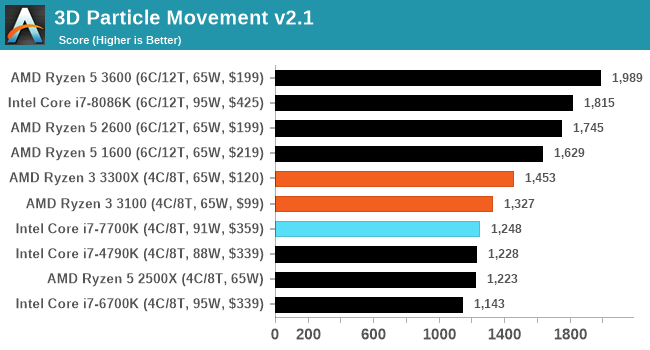
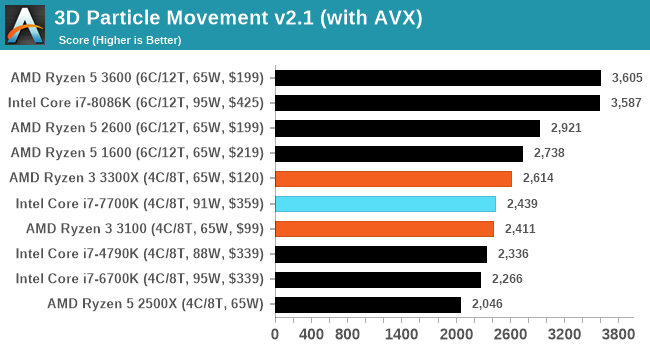
Dolphin 5.0: Console Emulation
One of the popular requested tests in our suite is to do with console emulation. Being able to pick up a game from an older system and run it as expected depends on the overhead of the emulator: it takes a significantly more powerful x86 system to be able to accurately emulate an older non-x86 console, especially if code for that console was made to abuse certain physical bugs in the hardware.
For our test, we use the popular Dolphin emulation software, and run a compute project through it to determine how close to a standard console system our processors can emulate. In this test, a Nintendo Wii would take around 1050 seconds.
The latest version of Dolphin can be downloaded from https://dolphin-emu.org/
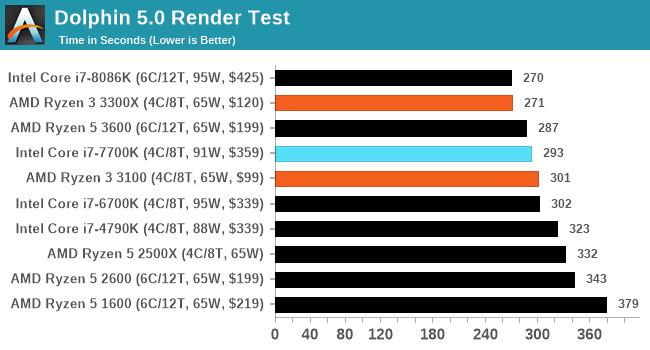
DigiCortex 1.20: Sea Slug Brain Simulation
This benchmark was originally designed for simulation and visualization of neuron and synapse activity, as is commonly found in the brain. The software comes with a variety of benchmark modes, and we take the small benchmark which runs a 32k neuron / 1.8B synapse simulation, equivalent to a Sea Slug.
Example of a 2.1B neuron simulation
We report the results as the ability to simulate the data as a fraction of real-time, so anything above a ‘one’ is suitable for real-time work. Out of the two modes, a ‘non-firing’ mode which is DRAM heavy and a ‘firing’ mode which has CPU work, we choose the latter. Despite this, the benchmark is still affected by DRAM speed a fair amount.
DigiCortex can be downloaded from http://www.digicortex.net/
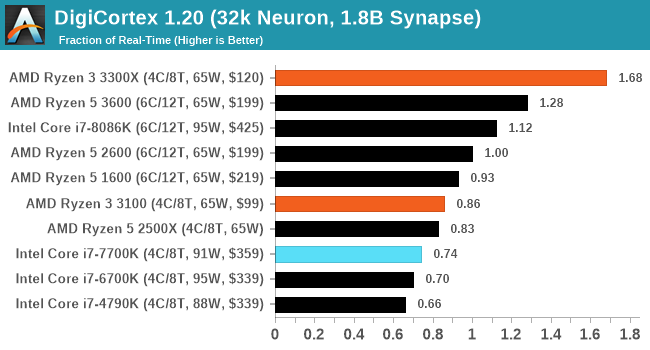
y-Cruncher v0.7.6: Microarchitecture Optimized Compute
I’ve known about y-Cruncher for a while, as a tool to help compute various mathematical constants, but it wasn’t until I began talking with its developer, Alex Yee, a researcher from NWU and now software optimization developer, that I realized that he has optimized the software like crazy to get the best performance. Naturally, any simulation that can take 20+ days can benefit from a 1% performance increase! Alex started y-cruncher as a high-school project, but it is now at a state where Alex is keeping it up to date to take advantage of the latest instruction sets before they are even made available in hardware.
For our test we run y-cruncher v0.7.6 through all the different optimized variants of the binary, single threaded and multi-threaded, including the AVX-512 optimized binaries. The test is to calculate 250m digits of Pi, and we use the single threaded and multi-threaded versions of this test.
Users can download y-cruncher from Alex’s website: http://www.numberworld.org/y-cruncher/
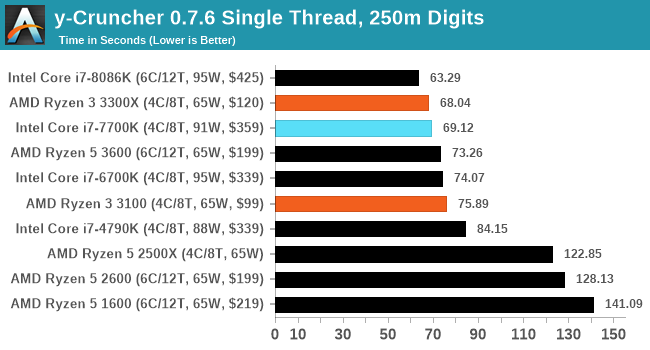
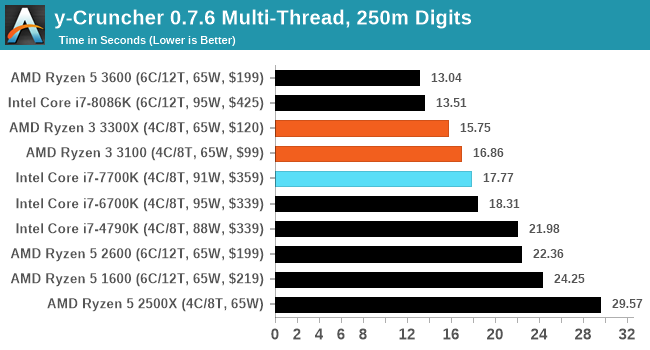
Agisoft Photoscan 1.3.3: 2D Image to 3D Model Conversion
One of the ISVs that we have worked with for a number of years is Agisoft, who develop software called PhotoScan that transforms a number of 2D images into a 3D model. This is an important tool in model development and archiving, and relies on a number of single threaded and multi-threaded algorithms to go from one side of the computation to the other.
In our test, we take v1.3.3 of the software with a good sized data set of 84 x 18 megapixel photos and push it through a reasonably fast variant of the algorithms, but is still more stringent than our 2017 test. We report the total time to complete the process.
Agisoft’s Photoscan website can be found here: http://www.agisoft.com/













249 Comments
View All Comments
lightningz71 - Friday, May 8, 2020 - link
Because I was typing it on mobile, didn’t proofread before I hit submit, and the spell checker didn’t flag it as being wrong because it doesn’t know context.It’s my fault, my mistake, and I normally strive to do a better job with my spelling in general. Thank you for pointing out my mistake so that I can be more cognizant of my future errors.
Holliday75 - Saturday, May 9, 2020 - link
Now I feel like a d*ck for pointing it out.In all honesty just poking fun and genuinely curious because I see this mistake made daily all over the place. Facebook, comments, even articles by professional journalists and a work email or two. I find it curious when I know the people who speak American English natively and still make this mistake.
Spunjji - Monday, May 11, 2020 - link
Well, Autocorrect is one answer - and the other is the paradoxical relationship between the long "oo" sound in in lose and the shorter "oo" sound in loose. It's hard to argue that the spelling shouldn't be the other way around, although I have no doubt would still trip over it even then.notb - Thursday, May 7, 2020 - link
Idle power draw is atrocious. How can it be this high?It's not even that I'm worried about the unnecessary electricity use or noise (which could make an analogous APU a lot less interesting for HTPC and NAS).
I'm just really shocked by interconnect using 16W when the cores it joins are hardly doing anything.
Does anyone know what is I/O die doing? Is there a 10W ASIC mining bitcoin or what?
eastcoast_pete - Thursday, May 7, 2020 - link
Hush! You're spilling the beans here (:Actually, if AMD had a highly efficient ASIC mining chip with good hash rates, I'd consider buying some. Same goes for Intel.
notb - Friday, May 8, 2020 - link
Actually Intel is a major FPGA maker, so you can get one of those. It's not that hard to find an open-source coin miner (even on GitHub).The comment stand though. I googled a bit and there's no clear explanation for the high idle uncore.
And 8-core mobile Zen2 chips use maybe 3W in idle. It's not like their IF is a lot slower or has less to do.
This makes me wonder if we're even going to see desktop/server 35W chips? Not to mention it would be nice if they offered TDP down of 25W...
Suddenly, I'm a lot less interested in an AMD-powered home server or NAS (and BTW: EPYC embedded lineup is still Zen-only).
kepstin - Friday, May 8, 2020 - link
If they do make desktop 35W chips, they'll probably be based on the integrated APU die. I suspect the increased idle power is due either to off-die IF link to the IO chiplet needing more power than IF within a die, or perhaps the (14nm) IO chiplet itself having higher power usage.notb - Friday, May 8, 2020 - link
I'm OK with this kind of uncore under load (it's how Zen works).And I don't really mind high idle in workstation CPUs. It's an acceptable compromise.
I just assumed that they'll adjust this for low-core CPUs, since these often go into home PCs used casually - spending a lot of time at idle / low. And under a cheap, slim cooler there will be a difference between 5 and 16W.
AMD will have to fix this in the APUs if they want to take on low-power segments (NAS, HTPC, tiny office desktops).
AFAIK Zen2 APUs will use the chiplet layout, not monolithic approach from the mobile offer. Hence, OEMs will probably use mobile chips anyway. DIY customers may have a problem.
Holliday75 - Saturday, May 9, 2020 - link
We've seen updates addressing issues with previous Zen CPU's. Possible it could be a miss on their part of just didn't have the time to tweak it before release.Namisecond - Thursday, May 7, 2020 - link
Thanks for detailing the two new AMD CPUs. Any news on the new desktop APUs though? I'm hearing rumors of up to 8 cores but the GPUs on them will be worse than the previous generation.